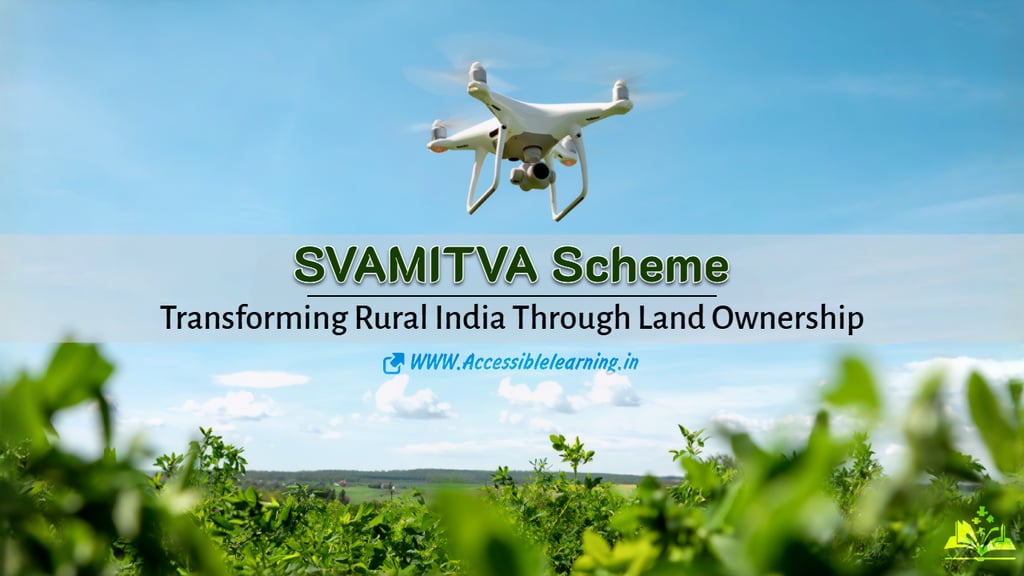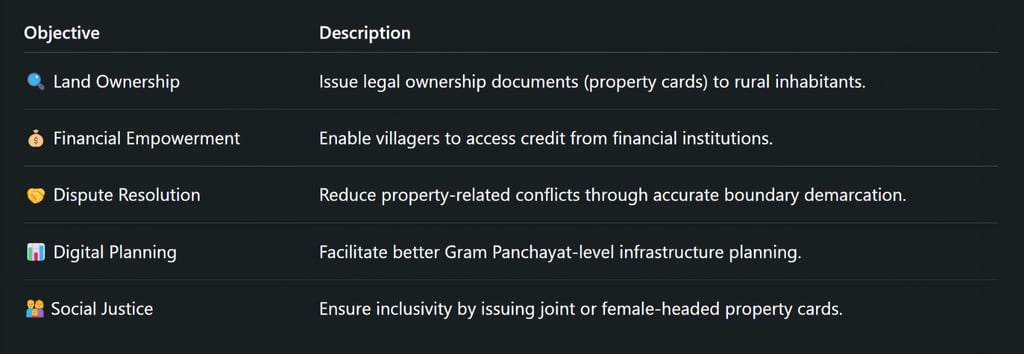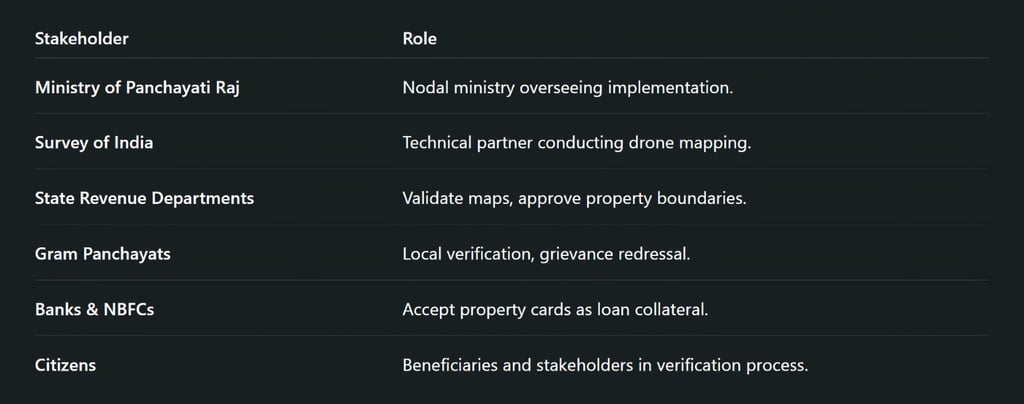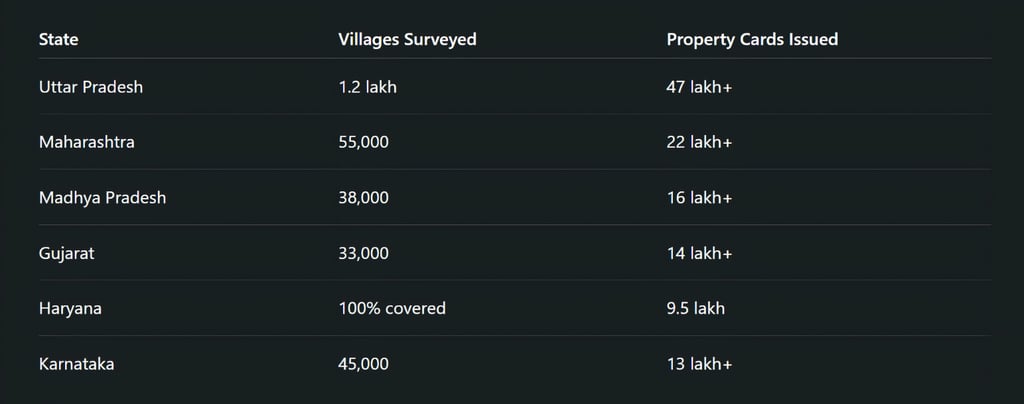
SVAMITVA Scheme Completes 5 Years: Digitizing Rural India, Empowering Every Home
The SVAMITVA Scheme marks its 5th anniversary in April 2025, revolutionizing land ownership across rural India. Discover its impact through drone mapping, digital property cards, financial empowerment, and a future of inclusive governance.
GOVERNMENT SKIMPOLITICAL JOURNEYAWARE/VIGILANT
Keshav Jha
4/26/20254 min read


April 2025 marks the 5-year anniversary of the SVAMITVA Scheme—a silent revolution that has changed the way rural India views land ownership. What began as a novel idea to settle land rights has evolved into a model of digital governance, social justice, and economic empowerment. Today, SVAMITVA stands as one of India’s most ambitious and impactful land reform missions.
What is the SVAMITVA Scheme?
The SVAMITVA Scheme (Survey of Villages and Mapping with Improvised Technology in Village Areas) was launched on April 24, 2020, by Prime Minister Narendra Modi under the Ministry of Panchayati Raj. The primary objective is to provide “Record of Rights” to property owners in rural abadi areas, using modern surveying technology like drones and GIS mapping.
The scheme targets gram abadi areas, which are often unrecorded in formal revenue maps. Without legal documents, rural citizens couldn’t sell their homes, obtain loans, or even prove ownership in legal disputes. SVAMITVA changed that.
5 Years of SVAMITVA: Milestones Achieved
Reach and Coverage
✅ 5.1 lakh villages surveyed out of a target of 6.62 lakh villages.
✅ 2 crore+ property cards issued to rightful owners.
✅ All 28 states and 3 UTs onboarded.
✅ Around 65,000 drone pilots were trained, many of them rural youth.
Technological Backbone
The Survey of India conducted high-resolution drone surveys.
Mapping linked to the Digital India Land Records Modernization Programme (DILRMP).
Village maps are now being geotagged and layered with local asset data on eGramSwaraj portals.
Blockchain-based pilots are being tested for tamper-proof land records in selected states.




Voices from the Ground
“Earlier, my home had no official value. Now with the SVAMITVA card, I got a loan to open a tailoring shop.”
says Rekha Devi, a resident of Uttar Pradesh.
“SVAMITVA helped resolve a 10-year boundary dispute with my neighbor. Now, we live peacefully.”
shares Mahendra Patil from Maharashtra.
“For the first time, our village is visible on a digital map. Our Panchayat uses it for planning roads and water lines.”
says Sarpanch Meena Bhagat from Madhya Pradesh.
Use-Cases of SVAMITVA Property Cards
Availing housing loans from public and private sector banks.
Selling or transferring property legally with registered proof.
Asset declaration for school admissions, jobs, or government subsidies.
Insurance coverage for rural homes and small businesses.
Urban-style ownership rights in the heart of rural India.
Integration with Other Schemes
PM SVANidhi: Helps street vendors avail loans using property as address proof.
PM Awas Yojana (Rural): SVAMITVA data aids in land identification for housing.
Jal Jeevan Mission: Mapping of water pipelines integrated with land maps.
Aadhaar + DigiLocker: Seamless integration for digital access to ownership documents.
FAQs
What is the SVAMITVA Scheme, and when was it launched?
The SVAMITVA Scheme (Survey of Villages and Mapping with Improvised Technology in Village Areas) was launched on April 24, 2020 by Prime Minister Narendra Modi. It aims to provide legal ownership of residential land in rural areas using drone-based mapping and property cards.
Who benefits from the SVAMITVA Scheme?
The primary beneficiaries are rural residents living in abadi areas (inhabited village lands), who previously had no formal ownership records of their homes. With SVAMITVA, they now receive legal documents proving ownership, which can be used for loans, selling property, and dispute resolution.
How does the drone mapping work under SVAMITVA?
Drones are used to conduct high-resolution aerial surveys of villages. These surveys help create accurate digital maps, which are then verified by local Gram Panchayats. Based on these maps, property cards are issued to each rightful landholder.
How many villages and property owners have benefited so far?
As of April 2025, over 5.1 lakh villages have been surveyed and more than 2 crore property cards have been distributed. The scheme is rapidly progressing toward covering all 662,000 villages in India.
Is the SVAMITVA Scheme linked with any other government programs?
Yes, it integrates with several initiatives:
eGramSwaraj for planning local development.
PM SVANidhi for helping street vendors access credit.
PM Awas Yojana (Gramin) for housing allotments.
Digital India Land Records Modernization Programme (DILRMP) for record syncing.
Can women hold property cards under SVAMITVA?
Absolutely! The government encourages joint ownership or woman-headed titles under the scheme to promote gender equity in land ownership. Many states report rising percentages of property cards issued in the name of women.
What are the main challenges faced by the SVAMITVA Scheme?
Some of the key challenges include
Drone restrictions in border/tribal areas.
Resistance to boundary demarcation in disputed zones.
Variations in state-level legal frameworks.
Digital literacy issues in remote villages.
What is the future roadmap for SVAMITVA?
The government aims for 100% village coverage by March 2026, deeper integration with AI and blockchain, and increased use of the data for rural planning, resource allocation, and digital governance. There’s also a push to ensure 50% of property cards are issued in the names of women.


Challenges Faced
Uneven adoption by states: Some lag in legal policy alignment.
Drone flight restrictions in border and tribal areas.
Manual errors during village-level verification.
Digital illiteracy among elderly rural residents.
Gender gaps in property ownership, though improving.
Looking Ahead: The Future of SVAMITVA
100% village coverage by March 2026.
Real-time land dashboards for planning rural infrastructure.
Integration with the One Nation One Registration portal.
AI-powered analytics for resource optimization in Panchayats.
Push for 50% property cards in the name of women under gender equity drives.
The SVAMITVA Scheme, now 5 years strong, has done more than deliver property cards—it has redefined rural dignity. It gave landowners a voice. It offered youth a skill. It handed villages a map—and a future.
As India gears toward digital governance and rural empowerment, SVAMITVA remains a symbol of equity, efficiency, and empowerment. With every drone flight and every verified document, it continues to map not just land, but hope.
Subscribe to our newsletter
All © Copyright reserved by Accessible-Learning
| Terms & Conditions
Knowledge is power. Learn with Us. 📚


